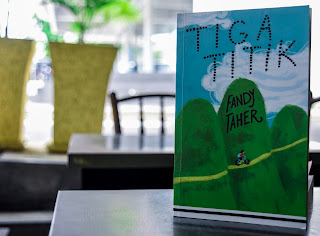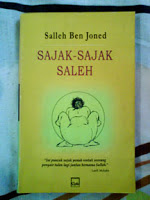Today theSun published an interview I have done with Wan Nor Azriq where he picks ten books that every Malaysian Hipster should read
Headline : A Hipster's Choice
By Bissme S
THE WORD ‘hipster’ is one of the more recent additions to the modern vocabulary, but even though most people can readily identify what a hipster looks like, it’s difficult to pinpoint what being a hipster actually means.
As author Wan Nor Azriq, 29, says: “If you can define a hipster, that means you not a hipster. Hipsters do not like labels and definitions.”
However, this award-winning author who penned DUBLIN, Boneka Rusia Guido, Dompet Kulit Buaya, 86 and Soneta Roda Basikal among others, agrees to help give a better idea of who a hipster is.
“Basically, a hipster fits the subculture that consists mainly of youngsters in their 20s and 30s living in urban areas such as Kuala Lumpur, Ipoh, and Johor Baru,” he says.
“Hipsters are very eco-friendly. They prefer walking or riding a bicycle to driving a car because it’s healthier. They listen to obscure independent bands. They hang out at fancy and eccentric cafes. “They read underground poetry, and above all else, they value authenticity, creativity, and freedom.
“Whatever is seen as mainstream and fashionable, they go against it. They strive for individualism.”
Here are Wan Nor’s list of 10 books that he says hipsters should read:
1) Aku Tak Peduli (Melayu Minimalis)
This book describes the hipster culture as well as the other subcultures that exist in Kuala Lumpur. The writer also talks about the Malaysian independent music scene. The way he writes is like he is having a conversation with you.
2)Awek Chuck Taylor (Nami Cob Nobbler)
This novel defined a generation of Malaysians the way J.D. Salinger’s Catcher in the Rye did for his generation in the United States. This book will definitely strike a chord with girls who dream of becoming a sophisticated and intelligent woman like Mira in the novel. The hero is not your typical hero. One can even say he is kind of a born loser. He also talks about his relationship with two girls who happen to be sisters.
3) Mat Som (Lat)
This graphic novel centres on about a youth from Tanjung Maim who settles in Kuala Lumpur. He hangs out with the ‘in’ crowd because he wants to be seen as intelligent and sophisticated. He gets interested in the literary scenes.
You will [recognise] some well-known personalites such as poet Usman Awang and writer Latiff Mohidin in the comic sketches.”
4)Stereo Genmai (Ridhwan Saidi)
This novel is perfect for hardcore hipsters. The story never moves in a liner fashion. It is very fragmented, and centres on a man looking for his girlfriend who goes missing after watching a movie. The story very clearly depicts the power of cinemas and films.
5)Tiga Titik (Fandy Taher)
The book is about a boy who runs away from home and wants to travel around the world on his bicycle. I think, in the heart of every true hipster, there is a strong desire to run away, not just from his birthplace, but also from mainstream culture. After you have finished reading Fandy’s inspiring novel, I guarantee you will pick up your bike and begin your journey into nature.
6) Catatan Latiff Mohidin (Latiff Mohidin)
Just like a true hipster, this book escapes any rigorous label you can put on it. [It’s] part journal, part aphorism, part poetry, and part literary criticism. He talks about the various topics under the sun – from life to literature.
7)Tapai (Hishamuddin Rais)
I choose this book because I think Malaysian hipsters are unique in their strong appetite for local and exotic food. So Tapai is the best food guide book you will find on the market as it combines Hishamuddin’s sharp witty observations and colourful descriptions of the many dishes that feed our Malaysian taste buds.
8) Kentang (Saharil Hasrin Sanin)
A blend of graphic humour and witty social critique, Saharil really knows how to entertain his readers while making them feel smart. A light read for hipsters who are too busy saving the world.
9)Kopi Lejen (Various authors)
Coffee is an important beverage for hipsters. This anthology feature three various short stories where the writers cleverly relate their personal experiences with coffee.
10) Sajak-Sajak Saleh (Salleh Ben Joned)
Indeed, Malaysian poetry doesn’t get any more vulgar and rebellious than the poems of Salleh Ben Joned. This book will appeal to the anarchist hipsters and angry young poets out there.
To celebrate Hari Raya, theSun feature a love story that goes beyond race and religion.
Headline: Love is the Answer
By Bissme S
For couple Najua Nasir, 34, and Muhammad Paul Ellingham, 49, love certainly proves to be the unifying force in their relationship and marriage.
Married for nine years, they are the proud parents to eightyear-old Aisha Marie Ellingham, seven-year-old Alana Jane Ellingham, and two-year-old Aila Claire Ellingham.
The couple first met in 2000 when Najua went to the United Kingdom with her aunt for a holiday.
“Paul was a friend of my aunt, and he came to the airport to pick us up,” she recalls.
At that time, Najua was 19 and Paul, 34. Despite the 15-year age gap between them, a close friendship soon developed between the pair.
Six years later, in 2006, Paul took on a position as an oil trader in Kuala Lumpur. When he moved and settled down in the country, he and Najua began to see each other more often. Slowly their friendship developed into a more serious relationship, and on July 7, 2007, they were married.
“I received my parents’ blessings,” Najua says on her choice of a foreign husband.
As she was not the first one in her family to marry someone from a different cultural and religious background, her relatives were more open to their mixed marriage. But there were other people who raised doubts about their relationship.
“They asked me why I had to marry a Mat Salleh, as if there were no more Malay guys left,” she says with a laugh.
Some even tried to frighten her by saying foreign men just like to have ‘fun’ with local girls and once that was over, they would abandon the girls and go back to their native land.
But Najua tuned out the negative comments made about her relationship with Paul and just held on to her faith in her husband. “One advice I would like to give to couples from different backgrounds who plan to get married is not to dwell too much on their differences,” she advises.
“All you need is to get your parents’ blessings, and I believe once you have that, everything will work out smoothly.”
When asked what drew her to Paul, she says: “He is a very positive person and has a great zest for life. You hardly see him looking sad.”
For Paul, it was his father who had encouraged him to marry Najua. “My father said it does not matter who I marry as long as I was happy,” he says.
“I never looked at Najua as a ‘Malay woman’. I see her as the woman I love.”
Paul did not have any reservations adapting to his wife’s religion and culture.
“I am still learning about Islam,” he says.
“My wife is helping me understand Islam better. [Anyway] even scholars take years to understand the religion.”
For every Ramadan since his marriage, Paul has undergone the fast. He then dresses up in his baju Melayu for the first day of Hari Raya. The first time he put on a baju Melayu was in 2006, for his company’s Raya open house.
He was very conscious about wearing the baju Melayu when he first put it on, he says, but now, he is more at ease.
“But I still need someone to tie the kain samping for me,” he adds with a laugh.
On the second day of Raya, Paul will be travelling to Alor Star to visit his in-laws.
“[My wife’s relatives] all treat me well and I feel very welcome and a part of the family,” he says.
“My Malay is limited and so is their English. But we will still try to have a conversation.
“Eastern culture emphasises on family relationships and I love that element very much.”
Their three daughters have no difficulty adapting to both cultures. “My parents are Christians, and my children are Muslims,” he says but adds that his parents love the children very much despite their cultural and religious differences.
“They often Skype us just to talk to my children.”
Paul points out that every marriage has its ups and downs, and theirs is no different.
“It is love that should keep you together,” he says.
“It is also love that helps you overcome all obstacles in the marriage.”
Indeed, one can never underestimate the power of love













